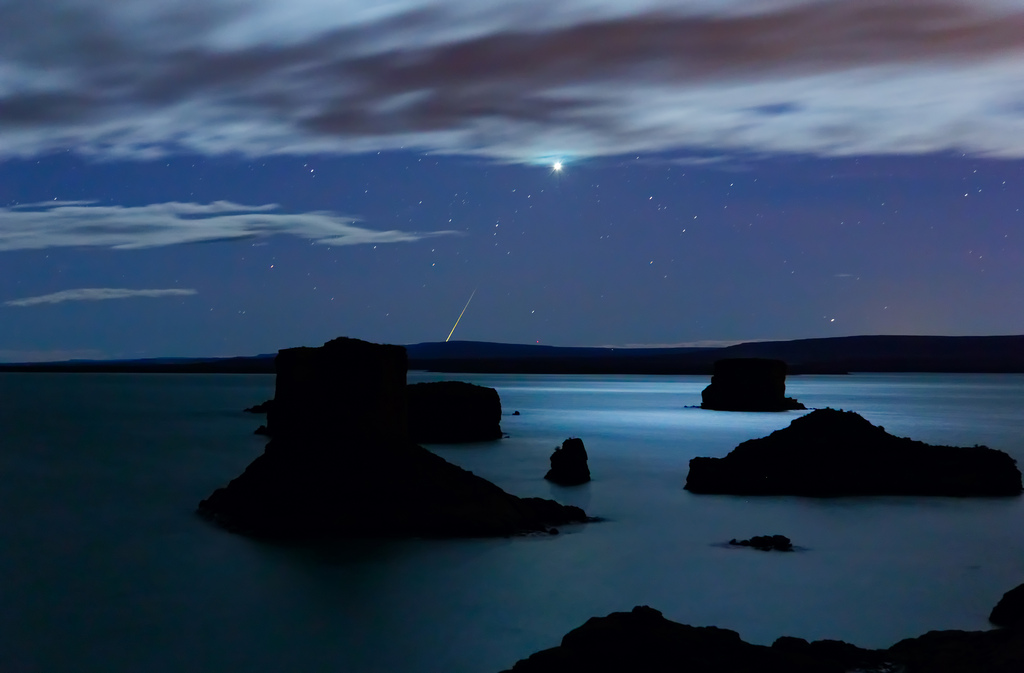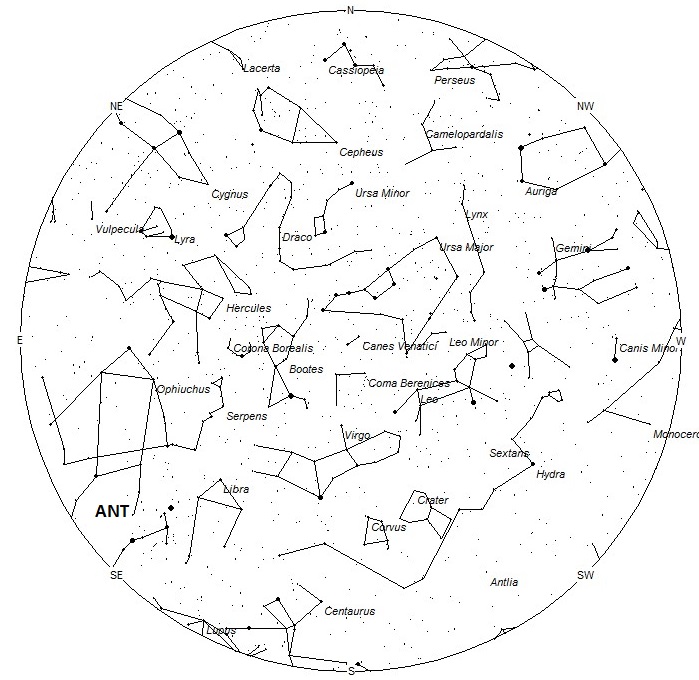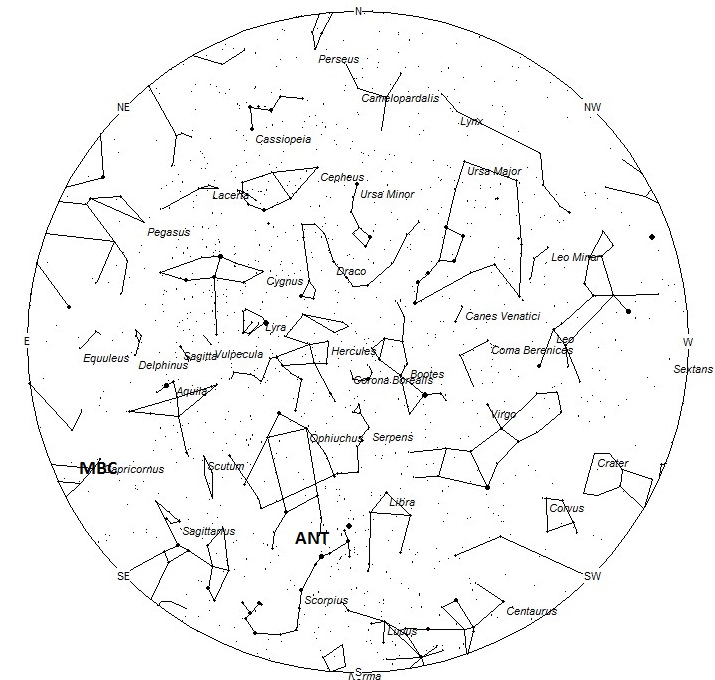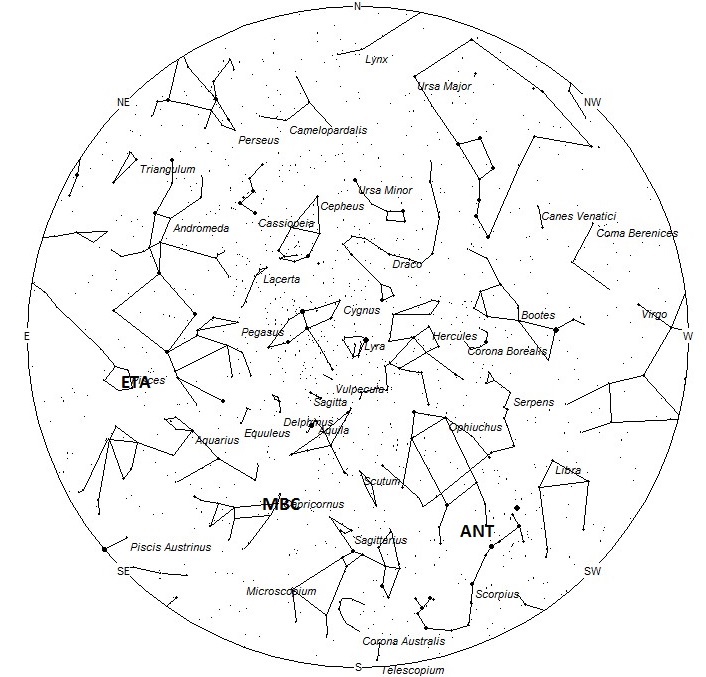
Fireball coming straight from below Venus and towards the horizon – ©Luis Argerich – Confluencia, Argentina – August 11th, 2013
During this period the moon reaches its new phase on Monday May 18th. At this time the moon will be located near the sun and will be invisible at night. As the week progresses the moon will enter the evening sky but will set during the early evening hours and will not cause any problems for viewing during the active morning hours. The estimated total hourly meteor rates for evening observers this week is near 3 for observers situated at mid-northern latitudes and 4 for observers viewing from the southern tropics (latitude 25 S.). For morning observers the estimated total hourly rates should be near 7 for observers situated at mid-northern latitudes and 12 for observers viewing from the southern tropics. The actual rates will also depend on factors such as personal light and motion perception, local weather conditions, alertness and experience in watching meteor activity. Note that the hourly rates listed below are estimates as viewed from dark sky sites away from urban light sources. Observers viewing from urban areas will see less activity as only the brightest meteors will be visible from such locations.
The radiant (the area of the sky where meteors appear to shoot from) positions and rates listed below are exact for Saturday night/Sunday morning May 16/17 These positions do not change greatly day to day so the listed coordinates may be used during this entire period. Most star atlases (available at science stores and planetariums) will provide maps with grid lines of the celestial coordinates so that you may find out exactly where these positions are located in the sky. A planisphere or computer planetarium program is also useful in showing the sky at any time of night on any date of the year. Activity from each radiant is best seen when it is positioned highest in the sky, either due north or south along the meridian, depending on your latitude. It must be remembered that meteor activity is rarely seen at the radiant position. Rather they shoot outwards from the radiant so it is best to center your field of view so that the radiant lies at the edge and not the center. Viewing there will allow you to easily trace the path of each meteor back to the radiant (if it is a shower member) or in another direction if it is a sporadic. Meteor activity is not seen from radiants that are located below the horizon. The positions below are listed in a west to east manner in order of right ascension (celestial longitude). The positions listed first are located further west therefore are accessible earlier in the night while those listed further down the list rise later in the night.
These sources of meteoric activity are expected to be active this week.
The center of the large Anthelion (ANT) radiant is currently located at 16:36 (249) -22. This position lies in southwestern Ophiuchus, 5 degrees northeast of the first magnitude orange star known as Antares (Alpha Scorpii). Due to the large size of this radiant, Anthelion activity may also appear from Libra, northern Lupus, Scorpius, and western Sagittarius as well as southern Ophiuchus. This radiant is best placed near 0100 Local Daylight Time (LDT), when it lies on the meridian and is located highest in the sky. Rates at this time should be near 1 per hour as seen from the northern hemisphere and 2 per hour as seen from south of the equator. With an entry velocity of 30 km/sec., the average Anthelion meteor would be of slow velocity.
The May Beta Capricornids (MBC) were discovered by members of the Croatian Meteor Network. These meteors are active from May 16-21, with maximum activity occurring on the 19th. At maximum the radiant is located at 20:20 (305) -15. This area of the sky is located in western Capricornus very close to the 3rd magnitude star known as Dabih (Beta Capricorni). This radiant is best placed during the last dark hour before dawn when it lies highest above the horizon in a dark sky. Rates at this time should be less than 1 per hour no matter your location. With an entry velocity of 68 km/sec., the average meteor from this source would be of swift velocity.
The last of the Eta Aquariids (ETA) will be seen this weekend from a radiant located near 23:04 (346) +03. This position lies in western Pisces, just south of the 4th magnitude star known as Beta Piscium. This radiant is best placed during the last dark hour before dawn when it lies highest above the horizon in a dark sky. Rates at this time should be less than 1 per hour no matter your location. With an entry velocity of 67 km/sec., the average meteor from this source would be of swift velocity with a high percentage of persistent trains on the brighter meteors.
As seen from the mid-northern hemisphere (45N) one would expect to see approximately 6 sporadic meteors per hour during the last hour before dawn as seen from rural observing sites. Evening rates would be near 2 per hour. As seen from the tropical southern latitudes (25S), morning rates would be near 10 per hour as seen from rural observing sites and 3 per hour during the evening hours. Locations between these two extremes would see activity between the listed figures.
The list below offers the information from above in a condensed form. Rates and positions are exact for Saturday night/Sunday morning.
| SHOWER | DATE OF MAXIMUM ACTIVITY | CELESTIAL POSITION | ENTRY VELOCITY | CULMINATION | HOURLY RATE | CLASS |
| RA (RA in Deg.) DEC | Km/Sec | Local Daylight Saving Time | North-South | |||
| Anthelions (ANT) | – | 16:36 (249) -22 | 30 | 01:00 | 1 – 2 | II |
| May Beta Capricornids (MBC) | May 19 | 20:20 (305) -15 | 68 | 06:00 | <1 – <1 | IV |
| Eta Aquariids (ETA) | May 07 | 23:04 (346) +03 | 67 | 08:00 | <1 – <1 | I |
 American Meteor Society
American Meteor Society


